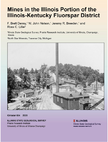| Mines in the Illinois Portion of the Illinois-Kentucky Fluorspar District
|

|
| Series
|
Circular 604
|
| Author
|
F. Brett Denny, W. John Nelson, Jeremy R. Breeden, and Ross C. Lillie
|
| Date
|
2020
|
| Buy
|
Web page
|
| Report
|
PDF file
|
| Map
|
PDF file
|
The mines within the Goose Creek Subdistrict are vein type and bedding replacement type that are aligned along the northeast-trending Goose Creek Fault Zone (Figure 25). The fault zone apparently comes together to the north and is a northwest boundary for the Rock Creek Graben. The mines in the Goose Creek Subdistrict are sometimes considered part of the Harris Creek Subdistrict.
Mines in the Goose Creek Subdistrict
| Goose Creek Mine
|
The Goose Creek Mining Company was operating this mine in 1952 from a shaft about 300 feet deep (Holtzinger and Roberts 1956; Baxter et al. 1963). Ozark-Mahoning files indicate that working levels were at 95, 120, 200, 256, 295, and 355 feet. An extension of this mine apparently connected with the Hoeb Mine along the 256-foot level. Ozark-Mahoning files indicate that at least 150,000 tons of raw ore was extracted from this mine.
|
| Hoeb Mine
|
In 1958, the Hoeb Fluorspar Mining Company discovered two blanket-type deposits adjacent to the Goose Creek Fault (McDougal and Foley 1959). These orebodies were at the 160- and 260-foot levels. The lower level was located just below the Bethel Sandstone (McDougal and Foley 1959). These coontail ore deposits were 25 to 30 feet wide and contained fluorspar, lead, and zinc. Information in the Ozark-Mahoning data set indicates that some stopes were also present along this vein and that working drifts were at the 100-, 160-, 260-, 335-, and 385-foot levels. Ozark-Mahoning data also indicate that the vein split into an east “main” vein and a west vein (Figure 26). The vein ore was also near the contact with the Bethel Sandstone and Renault Limestone. Maps indicate that along the main or east vein near the Hoeb Shaft, the west wall was the lower portion of the Cypress Sandstone and the east wall was the Glen Dean Limestone to Tar Springs Sandstone. Ozark-Mahoning files indicate that at least 86,000 raw tons of ore was extracted from this mine.
|
| Spivey Mine or Greene Mine
|
According to Myers and Chenoweth (2009), the Spivey Mine Company operated the Greene Fluorspar and Zinc Mine. The source for their work was Baxter et al. (1963). In Baxter et al. (1963), the mine was named Greene in the text and labeled Green on the map. This mine is sometimes spelled “Spivy,” but “Spivey” seems more common. This mine, which lies along the northeast extension of the Goose Creek Fault, was ready for production by November of 1971 but was placed on standby, awaiting better market conditions (Wood 1973). The Spivey lies northeast of the Hoeb, but the two mines were not connected in 1980. The Minerva Oil Company continued to develop the Spivey Mine by sinking a shaft to 685 feet, and the mine was expected to be in full production in 1975 (Wood 1976). The Spivey Mine was operated by the Minerva Oil Company in the 1970s, by Allied Chemical in 1979 (Kostick and DeFilippo 1980), and by the Inverness Mining Company in 1980 (Morse 1981). Mine maps from the Ozark-Mahoning data set indicate that in 1977, the mine was stope mining on the 300-, 450-, and 600-foot working levels. Both bedding replacement and vein ore were present in this mine. The vein ore was found at the base of the Bethel and extended down to the 600-foot level. Ozark-Mahoning data indicate that fluorspar was present between the Spivey and Hoeb Mines, but the data are insufficient to determine whether the ore was mined.
|
Figures
References
- Baxter, J.W., P.E. Potter, and F.L. Doyle, 1963, Areal geology of the Illinois Fluorspar District: Part 1—Saline Mines, Cave-in-Rock, Dekoven, and Repton Quadrangles: Illinois State Geological Survey, Circular 342, map, 1:24,000; report, 44 p. and 1 pl.
|
- Holtzinger, J.E., and L.C. Roberts, 1956, Fluorspar and cryolite, in M.J. Ankeny, ed., Minerals yearbook 1953: Metals and minerals (except fuels), Volume I: U.S. Department of the Interior, Bureau of Mines, Division of Minerals, p. 463–478.
|
- Kostick, D.S., and R.J. DeFilippo, 1980, Fluorspar, in L.D. Norman, ed., Minerals yearbook 1978–89: Metals and minerals, Volume I: U.S. Department of the Interior, Bureau of Mines, p. 341–357.
|
- McDougal, R.B., and J.M. Foley, 1959, Fluorspar and cryolite, in M.J. Ankeny, ed., Minerals yearbook 1958: Metals and minerals (except fuels), Volume 1: U.S. Department of the Interior, Bureau of Mines, Division of Minerals, p. 447–466.
|
- Morse, D.E., 1981, Fluorspar, in R.C. Horton, ed., Minerals yearbook 1980: Metals and minerals, Volume I: U.S. Department of the Interior, Bureau of Mines, p. 321–334.
|
- Myers, A.R., and C. Chenoweth, 2009, Directory of coal mines in Illinois, 7.5-minute quadrangle series: Saline Mines Quadrangle, Gallatin and Hardin Counties: Illinois State Geological Survey, map, 1:24,000; report, 28 p., 1 pl.
|
- Wood, H.B., 1973, Fluorspar and cryolite, in E.F. Osborn, ed., Minerals yearbook 1971: Metals, minerals, and fuels, Volume I: U.S. Department of the Interior, Bureau of Mines, p. 517–530.
|
- Wood, H.B., 1976, Fluorspar, in T.V. Falkie, ed., Minerals yearbook 1974: Metals, minerals, and fuels, Volume I: U.S. Department of the Interior, Bureau of Mines, p. 565–587.
|
Mines enter that are in the Goose Creek Subdistrict

